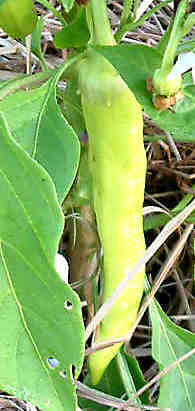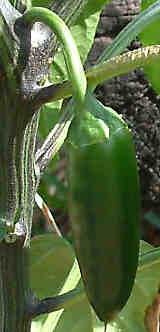Growing Peppers From Seeds, Part 2
I got a little carried away describing some different pepper seeds for different climates in my previous growing peppers from seeds post. So now let’s talk about the actual planting process.
What You Need
You’ll need the following to plant your pepper seeds. I germinate mine indoors, and then transplant them a little later. So here’s how to plant the seeds indoors, followed by directions for sowing seeds directly outdoors.
For indoors you will need:
- 3-ounce Dixie cups or windowsill seed starter tray.
- Spoon.
- Waterproof container to hold the cups (not needed if you are using the seed starter tray).
- Seed-starting soil or peat cylinders (comes with the seed starter tray).
- Hand sprayer that sprays a very fine mist of water.
- Scissors (if using Dixie cups).
- Seed packet(s).
Optional
- Labels to mark the pepper variety, plus a marker with waterproof ink.
Getting the Containers Ready
First, get the container(s) (Dixie cups or seed starter tray) ready with the soil, then dampen the soil. If you are using the Dixie cups, use the scissors to cut 4 small holes towards the bottom of the cups, for drainage. If you are using the seed starter tray, soak the peat cylinders in water according to the directions.
I like to use a small spoon to get the seed-starting soil into the Dixie cups.
If you are planting several varieties of seeds (which is what I like to do), you may want to label your containers with the varieties. You can use the waterproof markers and labels for the Dixie cups, or sketch a simple diagram of the windowsill seed starter tray.
Planting the Pepper Seeds
Once the soil or cylinders are damp. place the seeds in the cups/cylinders. I tend to plant 3 seeds in each Dixie cup, thinning to the strongest if they all germinate. Follow the directions as to number of seeds for the seed starting tray.
For the Dixie cups, you then want to place a fine layer of soil over the seeds. Don’t make it too deep, or the seeds will lose their strength just trying to get above ground.
When you are done planting, spray a fine mist of water over the soil. If you’re using the Dixie cups, put them in a waterproof container.
Then put some water at the bottom of the seed starter tray or the waterprood container. You want to water from below, to encourage the tiny plants to grow their roots deep instead of shallow. But be careful not to drown them! You want the soil damp, not wet.
You’re done! Now put the tray or container in a spot where it will be warm. When the seeds start to germinate, move them to somwhere where they will get plenty of indirect sun, or under grow lights.
Growing Peppers by Sowing Outside
It’s actually fairly simple to sow directly outside, but you must wait until all danger of frost is past, and the soil needs to be at least 60 degrees warm. Pick a sunny spot where the pepper plants will get plenty of sun.
Your biggest job will be preparing the soil outside. You want it loose enough so that the peppers can poke their heads above soil easily, but with enough nutrients to keep them going.
When I planted my peppers outside, I put plenty of compost and cow manure into the soil, then thoroughly mixed it to a depth of 6 inches. Depending on your soil, you may or may not need a tiller to help you with this. Dampen the soil when you are done; you want it moist, not wet.
Once your soil is prepared, plant your seeds about 18 inches apart. I like to plant three seeds in each set, then thin to the strongest one.
Cover the seeds with a fine layer of seed-starting soil, which makes it easier for the young plants to poke their heads above ground once they germinate. Mist with a sprayer until the soil is damp over the seeds.
And Now the Hard Part
The hardest part is waiting for the seeds to germinate. I’ve had them take as few as 5 days to as long as 3 weeks, and different varieties take different lengths of time to germinate. Just be patient and keep the soil moist.
There you go — planting your pepper seeds! If you’d like more detail on planting seeds of any kind, one book I like a lot is The New Seed Starter’s Handbook. Very detailed, you’ll be growing your own garden from seed in no time!
Growing Peppers From Seeds
Growing peppers from seeds isn’t as hard as you might think. The absolute hardest part is waiting for the seeds to germinate and poke their little heads above ground! (Well, that’s the hardest part for me, at any rate.) 🙂
So let’s take a look at what needs to happen in order to grow pepper plants from seeds.
Pick Your Pepper (Seeds)
First is to consider your climate, and where you plan to grow your pepper plants. Pepper plants love sunlight and warmth, so if you live in the Pacific Northwest, you’re a bit more challenged than someone who lives in the desert Southwest or Deep South.
If you live in a cooler climate, pick plants that produce peppers early in the season. It will take longer for the peppers to grow and mature, so an early season pepper is best. For sweet peppers, you may want to take a look at sweet banana peppers. These peppers are prolific and bear pretty early.
(Note: You don’t have to live in the Pacific Northwest to enjoy this pepper — you can grow it about anywhere.)
One further note about the Pacific Northwest climate is that hot chile peppers won’t get as hot where you live, compared to if you grew them in a warmer climate. Not sure why that happens, but be aware of it. Of course, deppending on the variety, they can be pretty hot anyway!
OK, say you live in a moderate climate; congratulations, you can grow about anything! If you have a fairly short Summer, you may want to stick with the earlier varieties (less than 60 days from transplant). But if you have a longer Summer, take your pick! One early-to-mid season bell which ripend to red that I like is called
Keystone bell pepper.
If you’re looking for a neat hot chili pepper to grow that produces and produces and then produces some more, think about Jalapeno M.
 Every time I have grown jalapenos, the plants have produced beyond expectations. I’ve always had plenty to eat, and plenty to share with family, friends and neighbors. In fact, one plant (planted in the garden in a large hole filled with compost) had so many peppers I almost considered selling them (the peppers, that is). It grew huge and was covered with jalapenos.
Every time I have grown jalapenos, the plants have produced beyond expectations. I’ve always had plenty to eat, and plenty to share with family, friends and neighbors. In fact, one plant (planted in the garden in a large hole filled with compost) had so many peppers I almost considered selling them (the peppers, that is). It grew huge and was covered with jalapenos.
OK, so most of my jalapeno plants didn’t go to quite those lengths, but each one has produced plenty of peppers for eating and sharing.
OK, you’re in the really southern climates with long summers and mild winters. You can grow just about anything as well, but hot chile peppers in particular love the climate. Of course, being a hot, hot, hot pepper lover, I choose habaneros and scotch bonnets. A nice one is Hot Paper Lantern habanero.
A word of warning for those of you who live in super-hot climates with strong summer sun — think about growing your peppers in dappled shade, or so they don’t get full sun from about noon to three. Living in South Florida, my summertime peppers do much better if they aren’t in full sun during the hottest part of the day.
And if anyone wants to check out more pepper seeds, take a look at this link for all kinds of pepper seeds.
To Be Continued…
This post has gotten longer than I had planned, so here’s part two of growing peppers from seeds, with the actual planting instructions.
Organic Fertilizer and Growing Peppers
My preference is for organic fertilizer, especially when it comes to growing anything (like peppers) that I plan to eat.  And while I realize that not everyone is comfortable with using organic, I really do think it’s best.
Organic Fertilizer and Worms
Now my absolute favorite is worm castings, but in the past it’s been difficult to find in small enough quantities for a reasonable price. However, here are some earthworm castings in the smaller quantities — I usually get it in the 15 lb size.
I like earthworm castings because they have always seemed to me (in my growing) that the plants just like the nutrients the castings give to the soil. No burning, totally organic, but nevertheless, quite concentrated; a fairly little amount can fertilize a lot of plants. Instead of mixing it in with my potting mix or garden soil, I just put a handful in each hole before I plant my seedlings or starters.
But I’ve found something else pretty recently that I like; it’s called Terracycle organic fertilizer.
You may be asking…TerraCycle? What the heck it that? Well, it’s liquified worm castings…or as described on the container, “worm poop”. Inelegant, but accurate. ;)  So, think worm castings, dissolved in water so that it’s neat and super-easy to use on your plants.
And one other thing about TerraCycle is that it’s actually packaged in recycled materials, which is better for the environment.  So altogether it’s great for the organically-inclined gardener.
Other Organic Fertilizers
Another organic fertilizer that I like is called fish emulsion. Yep, it’s pretty much what it sounds like; liquified fish. Great for the plants, although a little on the aromatic side. Still, it feeds the soil as well as the plants, so it still gets a two thumbs up in my book. You’ll find it in just about any garden center. Sometimes it’s in a power form other times it’s a concentrated liquid. In either case, you need to add water to it before using.
Can’t forget about plain old compost! You can buy it pretty much at any garden center, but try to find one labeled organic. I know, in theory it should be organic by definition, but labeled organic means that the manufacturer had to pass some pretty stringent guidelines to be able to call it organic.
If you have the space and the time to make your own compost, it’s absolutely fantastic!!!! I highly recommend it. Basically you need things like household garbage (not including anything with protein, fat or plastic) and a means to compost it, like a compost bin. Personally, I am eyeing the Yimby Tumbler Composter
— it’s on my wish list.
It generally takes a few months to create good compost, but there are some that can create compost in a month or so. But whether it’s one month or six months, the most important thing is that the result is well-composted. Here’s a hint; it’s ready when there is no smell to the compost; if it still has an odor, it’s not “done”.
Let’s not forget about cow or horse manure. Cow manure is easily found in a garden center. Horse manure is generally only available if you have horses or know someone else who does.  Poultry manure is relatively easy to locate as well.
These are the major organic fertilizers that are whole-plant. There are others that can be used as supplements, such as blood meal and bone meal. There are also soil amendments like vermiculite, perlite, coconut coir and sphagnum moss that can help you to lighten dense soils. You can also check out my post on soil amendments for more info.